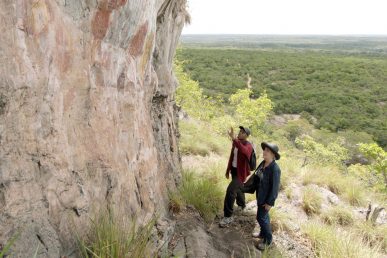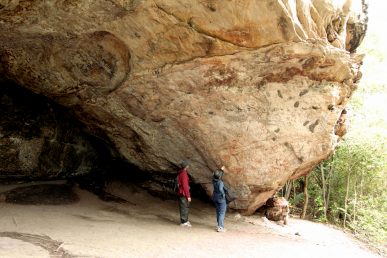PBS’ ‘Native America’ documentary features research by UIC anthropologists

UIC anthropologists Christopher Davis and Anna Roosevelt determine that a Paleoindian cliff painting may have been part of an ancient astronomical observatory. Photo: Providence Pictures
In 2007, Christopher Davis was a University of Illinois at Chicago anthropology graduate student working with Anna Roosevelt, UIC professor of anthropology, and other students at an archaeological site in Santarém, Brazil.
During a weekend excursion near the city of Monte Alegre along the Amazon River, Roosevelt took the group to 13,000-year-old rock art sites she previously researched with National Endowment for the Humanities grants and published about with colleagues in Science magazine. The experience at the jagged mountain walls and caves inspired Davis to conduct further investigation.
In the following years, he cataloged the images of people, animals and concentric circles at Serra do Ererê, the longest hill at the site. His dissertation revealed patterns representing constellations, planets and comets, and what may be the oldest evidence of an ancient astronomical solar observatory.
“It really starts to become this pictorial almanac,” said Davis, who earned master’s and Ph.D. degrees in anthropology from UIC. “My theory is they started to mark the position of the sun on the horizon throughout the year and in doing so they figured out the sun keeps coming back on a cyclical scale.”
Davis and Roosevelt returned to the site to discuss the findings while being filmed for the four-part documentary “Native America,” which premieres Oct. 23 at 9 p.m. on PBS.
The UIC anthropologists appear in the series’ first episode titled “From Caves to Cosmos,” which was screened on campus Oct. 18. The event was presented by the department of anthropology and UIC Honors College.
Made with the active participation of Native American communities, the series weaves history and science with living indigenous traditions to bring new perspectives on the connections between the ancient people of North and South America.
“That is very important, so you get this really interesting point of view,” Roosevelt said. “There is a huge amount of new material and wonderful visuals.”
“From Caves to Cosmos,” focuses on the cultural and social roots of Native America built across the two continents.

UIC’s Christopher Davis and Anna Roosevelt enter the Caverna De Pedra Pintada and discover some of the earliest known art in the Americas. Photo: Providence Pictures
“Many indigenous cultures had myths and ceremonies scheduled throughout the year, based on the appearance of different stars and constellations,” said Davis, who is an Honors College post-doctoral fellow in teaching and mentoring and has an honorary affiliation in the department of anthropology. “More recent cultures that we have ethnographic information about and many of the holidays and ceremonies they had were based on when they observed certain markers in the environment or in the sky.”
During filming, the production crew and the UIC researchers battled heat and vertical terrain while trying to capture the site’s paintings during the solstice.
“It was hard because the sun beats all afternoon on the hillside. It must have been 125 degrees Fahrenheit,” Roosevelt said. “There was a cavity in the contour of the hills you face as the sun sets. We waited until the sun set and it dropped as if into cupped hands.”
Davis’ research experience and discovery serve as good examples of the valuable fieldwork opportunities available to UIC’s anthropology graduate students, according to Roosevelt.
“The world is not yet fully known and there is a lot to discover,” she said. “The anthropology department has all these amazing anthropologists and I’m just one of many out in the wild, and in cities, training lots of students for unique innovative dissertations.”
Davis, who was a Fulbright grant recipient in 2011, credits the anthropology department’s assistance in promoting students for research funding.
“Once I had a grant it made it much easier to finish my dissertation research independently,” he said.
Co-sponsors of the screening are the Native American Support Program at UIC and UIC’s Rafael Cintrón Ortiz Latino Cultural Center.
